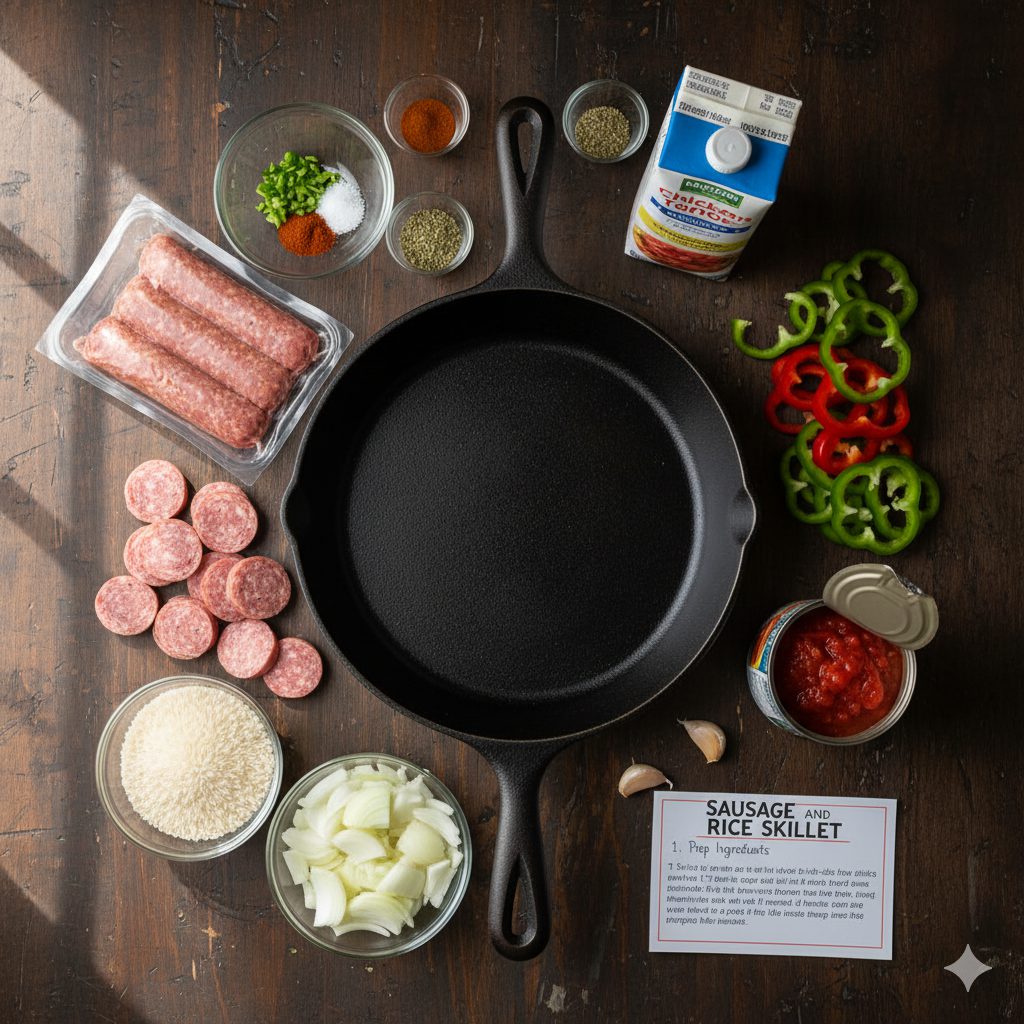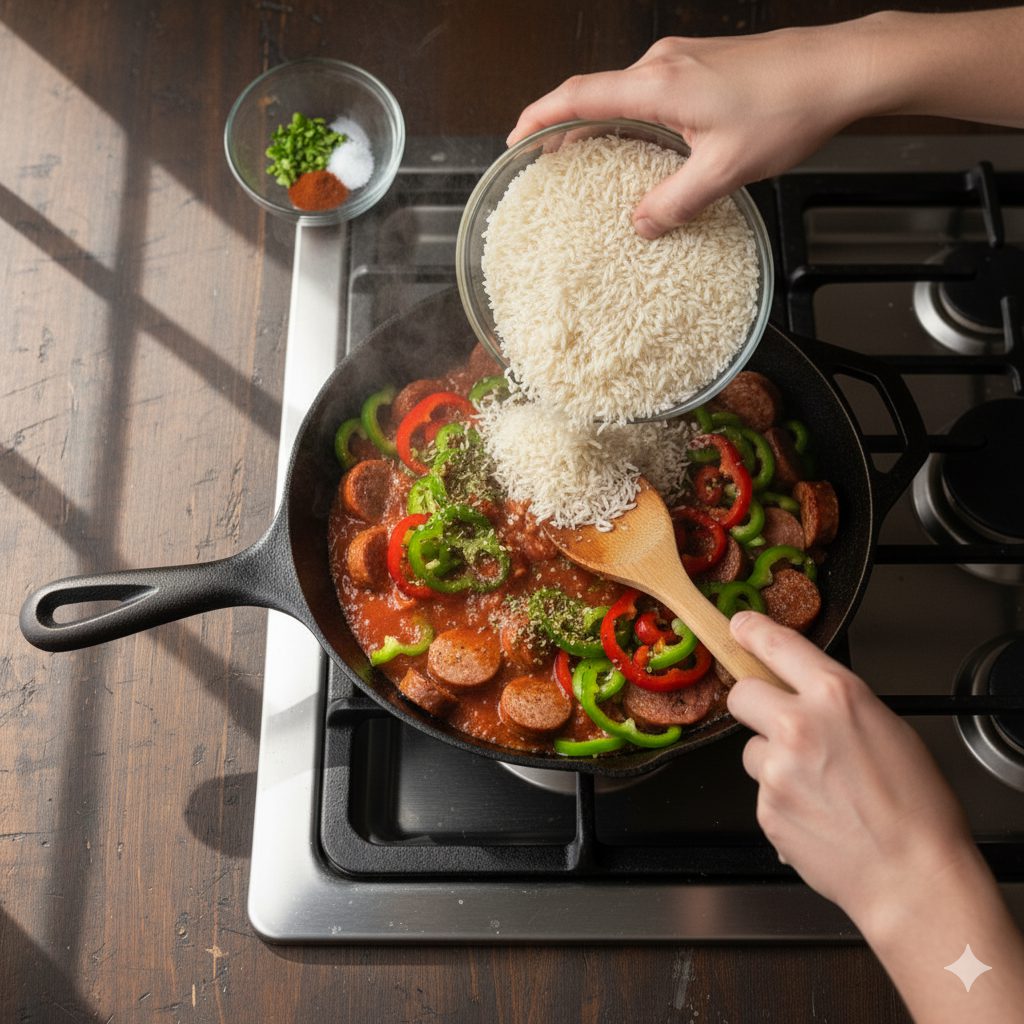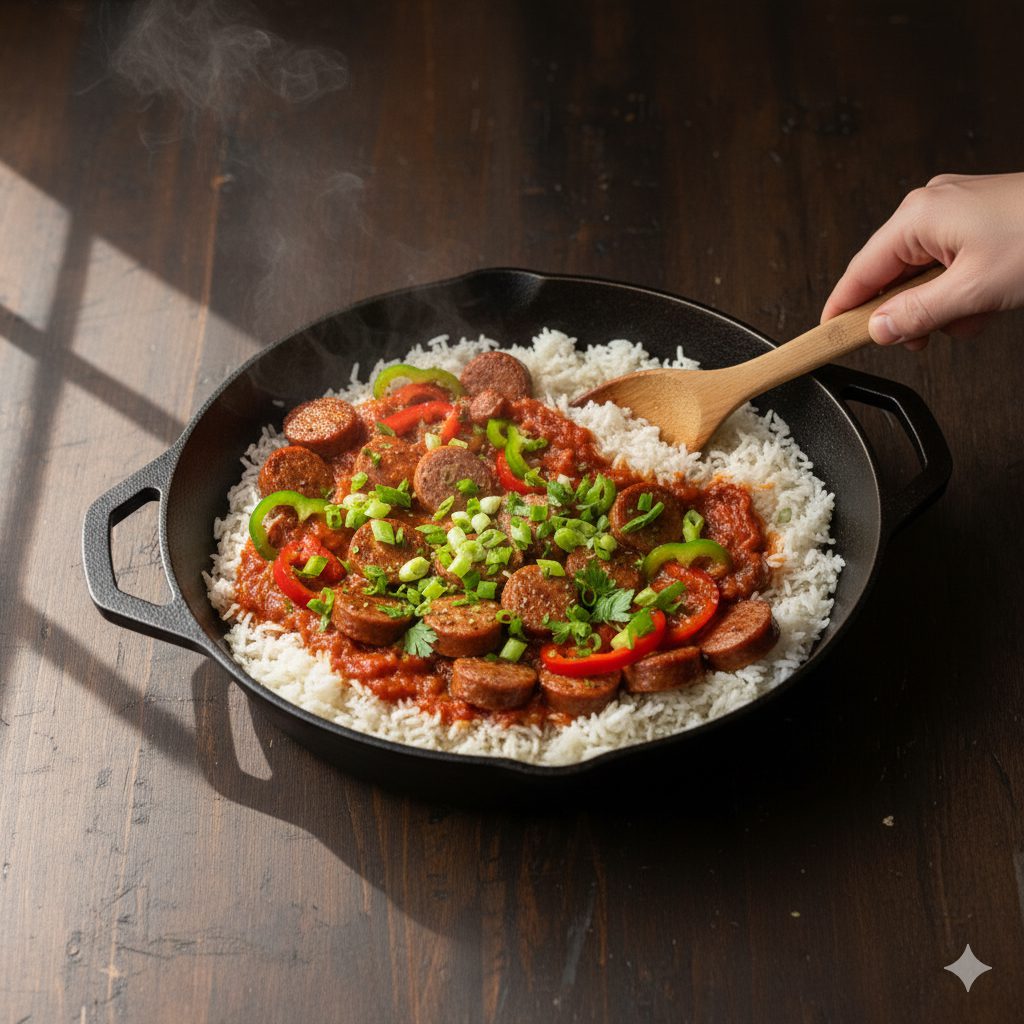
This one-pan wonder is about to become your new weeknight hero! Forget the endless chopping and sink full of dishes; the Sausage and Rice Skillet delivers maximum flavor with minimal fuss.
Imagine perfectly seasoned rice soaking up the savory juices of browned sausage, all cooked together in a single, beautiful pan. It’s the ultimate comfort food transformation—simple ingredients elevated to an unforgettable meal that the whole family will adore.
This isn’t just dinner; it’s a dinnertime revolution. From the smoky, satisfying sausage to the tender, well-spiced rice, every bite is a harmonious explosion of taste.
We’re talking rich, deep flavors reminiscent of a long-simmered meal, but ready in a fraction of the time. Get ready to kiss boring dinners goodbye and welcome this easy, delicious dish into your regular rotation. It’s fast, flexible, and fundamentally delicious.
SAUSAGE AND RICE SKILLET
Description
This Sausage and Rice Skillet is the definition of a satisfying, one-pan meal, perfect for busy weeknights.
It brings together robust flavors and simple ingredients for a comforting dish that's ready in a flash.
The foundation of the meal starts with browning your choice of sausage—from spicy Italian to mild chicken apple—which infuses the entire dish with its rich, savory character.
Aromatic vegetables like diced onions, bell peppers, and garlic are sautéed in the rendered sausage fat, adding sweetness and depth.
Uncooked rice is stirred in, absorbing all those delicious flavors before a broth (chicken, vegetable, or even a can of diced tomatoes) is added.
As the mixture simmers, the rice cooks to tender perfection, creating a moist, cohesive, and incredibly flavorful texture.
A final sprinkle of fresh parsley or a handful of sharp cheddar cheese elevates the dish, making it a complete meal that's both hearty and uncomplicated.
It's an adaptable, freezer-friendly favorite that delivers maximum flavor with minimum cleanup.
Ingredients
Instructions
-
Build the Flavor Foundation with Sausage and Aromatics
Ignite your flavor base by heating a substantial, high-sided pan or Dutch oven on a medium-high burner. Slice your smoked sausage into coin-shaped pieces and introduce them to the hot pan. Cook the sausage vigorously for approximately 5 to 7 minutes, occasionally flipping the pieces until they develop a deep, inviting golden crust. This step releases the savory drippings that will season the dish. When the pieces are ready, use a slotted implement to retrieve the sausage and move it to a clean plate, leaving the concentrated fat behind in the cooking vessel. Introduce the diced onion and cook for 3-4 minutes until softened, ensuring you scrape up any crusty, browned seasoning from the pan bottom as you stir. -
Infuse the Oil with Spices and Garlic
Temper the heat down to a medium setting. Introduce the finely chopped garlic, smoked paprika, and dried thyme directly into the pan's remaining rendered fat. Sauté the spice blend for precisely 60 seconds, continually stirring. Add the diced bell pepper, then continue cooking for two to three minutes until it reaches a pleasantly firm-tender state. -
Toast the Rice and Deglaze the Skillet
Pour the uncooked rice into the skillet alongside the vegetables. Agitate the rice briskly so that every kernel is covered by the spiced oil mixture. Maintain stirring for 1-2 minutes until you observe the rice grains starting to show a slight transparency at their edges. After toasting, introduce the can of unopened fire-roasted diced tomatoes (liquid included). Mix vigorously for about one minute; the tomato liquid will release the caramelized seasoning from the pan floor. -
Simmer and Cook the Rice to Perfection
Introduce the two cups of chicken or vegetable stock. Stir one time to unify the pot's contents, then raise the heat to bring the liquid to a full, bubbling rapid boil. Immediately lower the heat to its minimum setting, firmly seal the skillet with a lid, and allow the mixture to gently cook without interruption for 18 to 20 minutes. Crucially, do not remove the cover during this phase. -
Combine, Rest, and Garnish
Following the 18-20 minute cook time, remove the skillet from the heat source but leave the lid in place for an additional 5 minutes of rest. This brief resting period finalizes the cooking process, yielding light, fluffy rice. Remove the lid, incorporate the earlier reserved sausage pieces, and delicately separate the rice grains with a fork to distribute all components evenly. Season to taste and finish with a generous scattering of fresh parsley.
Nutrition Facts
- Amount Per Serving
- Calories 500kcal
- % Daily Value *
- Total Fat 28g44%
- Saturated Fat 9g45%
- Cholesterol 60mg20%
- Sodium 800mg34%
- Total Carbohydrate 45g15%
- Dietary Fiber 4g16%
- Sugars 6g
- Protein 22g44%
- Calcium 80 mg
- Iron 3 mg
* Percent Daily Values are based on a 2,000 calorie diet. Your daily value may be higher or lower depending on your calorie needs.
Note
The One-Pan Wonder: Mastering the Sausage and Rice Skillet
The Sausage and Rice Skillet is a beloved weeknight hero—a dish that offers maximum flavor with minimum fuss. This comprehensive guide provides expert tips, serving suggestions, creative variations, proper storage techniques, and a conclusive look at why this skillet meal deserves a permanent spot in your culinary rotation.
Essential Tips for Skillet Success
Achieving the perfect Sausage and Rice Skillet is less about complex technique and more about smart timing and ingredient preparation.
1. Searing the Sausage is Non-Negotiable: Before adding anything else, brown the sausage thoroughly. Whether you're using crumbles from a casing or sliced links, searing develops a deep, caramelized flavor that forms the foundation of the dish. This initial step also renders out fat, which you'll use to sauté the aromatic vegetables, infusing them with savory depth.
2. The Allium Bloom (Aromatics): After browning the sausage, remove it and use the rendered fat to sauté your foundational aromatics—typically onions, garlic, and perhaps bell peppers or celery (the "holy trinity" in some regional variations). Tip: Add garlic last, cooking it for only about 60 seconds to prevent burning, which can turn its flavor bitter.
3. Taming the Tomato Paste: If your recipe calls for tomato paste (highly recommended for depth), push the vegetables aside and cook the paste directly on the hot skillet bottom for one to two minutes, stirring constantly. This process, known as "pizzaiola," caramelizes the sugars in the paste, intensifying its umami and sweetness, preventing a raw, metallic flavor in the final dish.
4. Toasted Rice for Texture: Once the aromatics are softened, add the uncooked rice (long-grain white rice or medium-grain varieties work best). Stir it with the sautéed ingredients for a few minutes. This process lightly "toasts" the rice grains, which helps them hold their shape better during the long simmer, resulting in a less sticky, more distinct grain structure in the finished dish.
5. The Right Liquid and Technique: Use hot or warm stock (chicken or vegetable) instead of cold water. Adding cold liquid drastically drops the temperature of the skillet, disrupting the cooking process. Maintain a gentle simmer—too vigorous a boil will cause the rice to cook unevenly and the liquid to evaporate too quickly. Once the liquid is added, bring it to a simmer, stir once, cover tightly, and resist the urge to peek! Lift the lid only after the minimum required cooking time (usually 15-20 minutes).
Serving Tricks and Plating Prowess
While a skillet meal is inherently rustic, a few simple tricks can elevate its presentation and maximize enjoyment.
1. The "Resting" Reveal: This resting period allows the steam to finish cooking the rice evenly and makes the dish fluffier.
2. Garnish is King: Before serving, sprinkle generously with freshly chopped herbs: parsley, chives, or cilantro work well, adding a burst of color and fresh flavor that cuts through the richness of the sausage. A dollop of plain Greek yogurt, sour cream, or a drizzle of hot sauce adds a creamy or spicy counterpoint.
3. Family-Style Flair: Serve the skillet directly at the table on a trivet for a comforting, family-style experience. Alternatively, use a large, shallow bowl to plate, making sure to distribute the sausage and vegetables evenly, perhaps with a final scattering of grated Parmesan cheese for an extra layer of flavor.
Creative Variations: Beyond the Basics
The Sausage and Rice Skillet is a blank canvas, adaptable to myriad global and seasonal flavors.
1. Spanish Paella Inspired: Replace white rice with Arborio or medium-grain rice. Use Spanish chorizo (cured or fresh), smoked paprika, a pinch of saffron, and incorporate peas and roasted red peppers. Use fish or chicken stock for the liquid.
2. Italian Sausage and Peppers: Incorporate the classic pairing of bell peppers and onions, and swap the stock for crushed San Marzano tomatoes and a splash of red wine. Finish with fresh basil and mozzarella pearls.
3. Cajun Jambalaya: Use andouille sausage and swap the bell peppers for the "holy trinity" of onion, celery, and green bell pepper. Add a generous amount of Cajun seasoning (not just cayenne), and perhaps a few shrimp during the last five minutes of cooking.
4. Indian Curry Skillet: Use a mild chicken or pork sausage. Sauté with onion, ginger, and garlic, then add curry powder, cumin, and turmeric. Use coconut milk and chicken stock as the liquid, and finish with a squeeze of lime and cilantro.
5. Vegetarian/Plant-Based Swap: Replace the sausage with a hearty substitute like sliced portobello mushrooms, crumbled vegetarian "sausage," or pan-fried halloumi cheese. Ensure you add a tablespoon of olive oil at the start to replace the rendered sausage fat for flavor.
Storage and Reheating Protocol
Proper storage ensures the leftovers are just as delicious and safe to eat.
1. Refrigeration: The Sausage and Rice Skillet can be safely refrigerated for 3 to 4 days.
2. Freezing (Use Caution): While the dish can be frozen for up to 3 months, cooked rice texture can become slightly grainy upon thawing and reheating. If freezing, use a very well-sealed, freezer-safe container to prevent freezer burn.
3. Reheating: The best method is to reheat on the stovetop. Place the desired portion in a pan over medium-low heat and add a splash of water or stock (about 1-2 tablespoons per serving). For small portions, the microwave is acceptable, but sprinkle with water and cover the dish before heating.
Conclusion: The Unsung Dinner Hero
From the initial sear of the sausage to the final flourish of fresh herbs, mastering this skillet means mastering a foundational, adaptable technique that can be translated across countless cuisines. It’s the ultimate solution for a delicious, stress-free weeknight, confirming its status as a timeless culinary staple.









